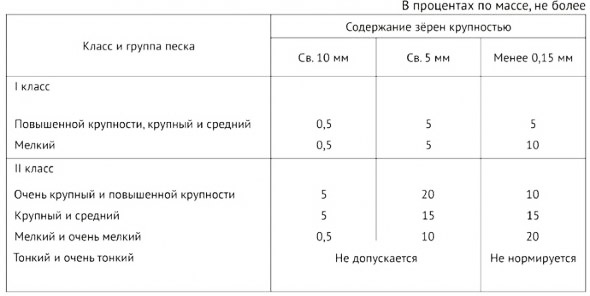Method for determining bulk density. Natural stone materials
For any bulk material used in construction, accurate determination of bulk density is important. The consumption and correct preparation of solutions for which, in fact, it is purchased, depend on this indicator.
The density of sand is the amount of sand that fits in a certain volume (cubic meter). And first of all, it depends on the factional composition. fits into a cube more compactly than large grains, so its mass will be higher. Small and dusty fractions in the same volume will be even heavier.
The total mass of grains placed in a conventional cubic meter is taken as the average density and is used for calculations. When shrinking or artificial compaction, this figure increases by 100-150 kg/m3. The quality and efficiency of the mixtures produced, as well as the strength of structures and coatings, largely depend on this characteristic of the building material. For example, river sand, due to its low porosity, can reduce the consumption of binder in the solution.
At the same time just as high volumetric weight material mined by open pit mining, on the contrary, indicates that quarry sand is heavily contaminated with clay particles. It is impossible to use low-quality filler in solutions, since foreign inclusions reduce the strength of the finished structures. Various impurities can make building material heavier or lighter, therefore medium density one can judge the quality of the mineral mass and the possibility of its use. But this indicator must be determined taking into account other parameters: size, origin, humidity level.
What affects density?
Bulk density in pure form depends only on the size of the grains and their compaction. But since the enriched mass is rarely used, foreign impurities also have to be taken into account.
The bulk density of construction sand per cubic meter increases due to:
- clay inclusions;
- soil residues;
- large rock fragments.
An interesting effect is produced by water falling into dry sand. Until its humidity reaches its natural level, bulk weight increases due to the displacement of air. But as soon as you “step over” this line, the volume begins to increase and the density decreases. By the way, fine material crosses this line faster because it initially has less porosity.
The mineralogical composition also plays a role, but here everything depends on the deposit and the extraction method. Heterogeneous quarry has a density of 1400 kg/m3, and a cube of purified quartz weighs 1550 kg, since its grains are slightly heavier.
The river one stands apart altogether. Even under natural conditions, it is cleared of clay impurities and contains practically no dust particles. In addition, all its grains are round in shape and therefore are placed in a conventional cube with minimal gaps. As a result, dried river sand has a relatively high bulk weight - 1650 kg/m3.

Calculation
If the bulk material has already been delivered to the site, its bulk weight per cubic meter can be determined on site. To do this, you only need a suitable container and scales. It will be more convenient to use a bucket and weigh with an ordinary steelyard, designed for 20-25 kg.
Density determination:
1. Weigh the empty bucket and write down the result (let’s say 1500 g) - it will be needed for further calculations.
2. For the purity of the experiment, pour the material into a bucket from a small height, and carefully remove the pile with a scoop.

3. Weigh the now full container again and subtract the container from the result obtained. For example, weighing showed 17 kg, which means that the bulk mass in a state of natural humidity is equal to:
- 17 – 1.5 = 15.5 kg.
4. Divide the resulting weight by the volume of the bucket and convert it to kilograms per cube:
- 15.5 kg / 10 l = 1550 kg/m3.
In the same way, you can determine the density of natural sand using a rectangular box. It needs to be weighed and the internal volume measured, converting the result into cubic meters.
To reduce measurement and weighing errors, the entire procedure can be repeated 2-3 times, collecting fine sand from different points. The calculation results are averaged, producing a general indicator.
Natural stone materials
The properties of natural stone materials are determined, first of all, by the properties of the rock from which they are obtained. The quality of a rock depends on its origin (genesis), mineralogical composition, structure (structure), composition (texture) and degree of weathering. The wide variety of structures and textures of rocks causes the same variety of construction and technical properties of stone materials. The study of these properties is of great importance when assessing rock as a raw material for the production of stone materials, as well as for determining the quality of the stone materials themselves and the degree of their suitability for construction.
The quality of rocks and stone materials made from them used in road and bridge construction is determined by studying:
physical properties rocks, which include density, bulk density, porosity, humidity, water saturation, frost resistance, cementing ability, thermal conductivity, sound conductivity, etc.;
mechanical properties- compressive strength, tensile strength, crushing strength, impact load (viscosity), abrasion resistance, wear resistance, etc.;
shape matching
, sizes and quality of processing of stone materials (crushed stone, checkers, paving stones, side and rubble stones) specified by standards or instructions.
The properties of stone materials are determined in laboratories using average samples, as well as from the results of observing the behavior of the material in experimental areas.
When studying methods for testing stone materials and their results, you should always keep in mind that they are to some extent arbitrary and cannot always correctly indicate the possible behavior of the material in practice. To objectively study the properties of materials, it is necessary to accurately perform tests, accumulate a large amount of test data, study and analyze this data, and, finally, compare them with the already known practice of the behavior of the material in practice. Imperfection of methods for determining the properties of materials, sloppiness in definitions and fragmentation of indicators lead to erroneous conclusions about the quality of the material.
The ability to accurately determine the properties of materials is especially important when using local, little-known stone materials for construction.
Equipment for testing in laboratories during construction, conditions and sequence of tests must strictly meet the requirements of the relevant GOSTs and instructions.
For any laboratory tests, data from preliminary theological, visual determinations of rock samples on site, directly in the field, are very valuable.
According to the rules of geology, with the help simple devices and reagents (binocular or simple magnifying glass, ruler with millimeter divisions, knife, steel needle, acids, blowpipe) you can often determine the minerals that make up the rock, its structure and texture, which is studied in a geology course.
The average sample is taken from a rock deposit or batch of supplied stone material and should represent the average quality of the entire deposit or batch. The procedure and method for collecting average samples is usually indicated in the relevant GOST or instructions.
Physical properties.
According to the Unified International System of Units (SI), old concepts specific gravity, volumetric weight, volumetric bulk density are replaced for more precise designation by the concepts of density, bulk density and bulk density, respectively. The SI unit for these quantities is kilogram per cubic meter (kg/m3). Gram per cubic centimeter (g/cm3), ton per cubic meter (t/m3) are used as submultiple and multiple units of measurement in technology.
The density (specific gravity) of the original rock is determined as the ratio of the resting mass mineral substance without pores and voids to its volume.
To determine the density, a rock sample is crushed and sifted through a 0.15 mm sieve, then dried. When determining density using a pycnometer, two samples weighing 10 g each (t) are weighed from the dried powder for parallel testing. Each sample is poured into a dry pycnometer, filled with water to half the volume of the pycnometer and boiled for 15-20 minutes. Then cool, add water to the mark and weigh (t2). After this, weigh the same pycnometer filled clean water to the mark (t1). Density is calculated using the formula
http://pandia.ru/text/77/504/images/image002_116.gif" width="208" height="54 src=">
The density of most stone materials is in the range of 2.7-2.9 g/cm3, and in igneous rocks it is higher than in sedimentary rocks, for example: the density of basalt, diabase, gabbro, diorite reaches 3.2 g/cm3.
Volumetric mass.
Volumetric mass (volumetric weight) is the mass per unit volume of a dried stone with pores in its natural state. The volumetric mass is expressed in grams per cubic centimeter (g/cm3), or in kilograms per cubic meter and is calculated using the formula
The sample mass m is determined by simple weighing, and the volume V is determined in several ways. With the correct geometric shape of the sample with smooth surfaces, the volume is determined by direct measurement. The volume is most accurately determined by hydrostatic weighing based on the mass of displaced water.
The volumetric mass of a rock is always numerically less than its density, since the mass of a given material in its natural state (with pores) occupies a larger volume than the same mass without pores. For example, the volumetric mass of granite is approximately 2.6 g/cm3, and its density is 2.7 g/cm3; the volumetric mass of Artik tuff is 0.75-1.4 g/cm3, and its density is 2.7-2.8 t/cm3.
The bulk density of a rock material depends on porosity and on the mineralogical composition, because different minerals have different densities.
Knowledge of the volumetric mass of the material is necessary for calculations during the design and construction of a structure.
In road and bridge construction, loose, bulk materials (crushed stone, gravel, sand, various binders) are widely used.
When selecting concrete mixtures, during storage, and transportation, it is necessary to know the mass of freshly poured materials.
The mass of these materials will be less than the volumetric mass of individual grains and pieces of stone material due to the voids between the individual grains filled with air. Therefore, another concept was introduced - bulk mass.
Bulk mass(volumetric bulk density) is the mass of bulk material per unit volume together with voids. Bulk mass is expressed in kilograms per cubic meter (kg/m3) or in tons per cubic meter (t/m3) and is calculated using the formula
http://pandia.ru/text/77/504/images/image004_67.gif" width="208" height="54 src=">
where p is the density, g/cm3; p0 - volumetric mass, g/cm3; Vpore - porosity, %,
Porosity and voidness have great influence on such properties of stone material as weight, water absorption, thermal conductivity, sound conductivity, frost resistance, strength. Stone material with low porosity (up to 5%) is heavier, more durable, less water-absorbing and more frost-resistant. This is the material most often used in road construction.
Water absorption.
Water absorption - the ability of the rock to absorb water when kept in water for a long time, at normal atmospheric pressure and a temperature of 18-20 ° C.
To determine water absorption, three to six cube-shaped samples with an edge length of about 6 cm are taken, dried to constant weight at a temperature of 105-110 ° C, cooled and weighed (t). Then the samples are immersed in water for 48 hours so that the water layers are 2 cm above the samples. After 48 hours, the samples are removed, wiped with a damp soft cloth and immediately weighed separately (m1). Water absorption is calculated as a percentage by mass Wm or by volume Wvol using the following formulas:
DIV_ADBLOCK16">
Water loss or moisture loss- this is a property that characterizes the rate of water removal from a stone (drying), when the elasticity of water vapor in the stone is higher than its elasticity in the external environment. The water yield of different stone materials is different and depends on their structure and environmental conditions. This property is determined in the laboratory by drying water-saturated samples until a constant mass is obtained. The water loss indicator is the time in hours required to dry the sample to constant weight
Frost resistance.
Frost resistance- the ability of a rock in a water-saturated state to withstand repeated alternating freezing and thawing. When water freezes, it increases in. volume by about 10% and the resulting ice puts pressure on the walls of the material, reduces its strength, and eventually destroys it.
IN road surface stone material finds itself in particularly difficult conditions. In autumn it is almost always completely saturated with water, and in winter... In the spring it freezes and thaws alternately. At the same time, the material experiences enormous loads from cars passing along the road.
All rocks with water absorption above 0.5% are tested for frost resistance. This test is carried out on cubic samples measuring 5x5x5 cm or cylinder-shaped with a height and diameter of 5 cm. The test consists of alternately freezing and thawing water-saturated samples at temperatures of minus 20° and plus 20°. The number of freezing and thawing cycles is assumed to be up to 200 or more, depending on the class of the structure and the operating conditions of the stone material in the structure. The rock is considered to have passed the frost resistance test if no damage in the form of cracks, delamination, rounding of edges and corners is found on the samples.
For a breed that has passed the frost resistance test, the degree of strength reduction is determined, which is expressed by the frost resistance coefficient.
The frost resistance coefficient Kmrz is calculated using the formula
http://pandia.ru/text/77/504/images/image007_41.gif" width="180" height="60 src=">
where Rcom is the compressive strength, kg/cm2;
R- the greatest load at which the sample was destroyed, kgf;
F- sample support area, cm2.
Along with determining the compressive strength of rock, tensile and shear strength is determined.
Tests are carried out on samples of the correct shape. Tensile strength is determined using a tensile testing machine with a device in the form of a special gripper for cylindrical samples; for shear - in conventional compression presses with a device.
To determine the degree of reduction in the strength of water-saturated stone materials compared to dry ones, a numerical characteristic was introduced in the form of a softening coefficient. Thus, the softening coefficient characterizes the water resistance of the material and is determined by the formula
Square meter" href="/text/category/kvadratnij_metr/" rel="bookmark">square meter), For example, brand 1200, brand 500, etc.
Impact resistance.
Impact strength
. The property of a stone to collapse under impact load is called brittleness. The fragility of a stone material depends on the mineralogical composition, the nature of adhesion between individual minerals, the cementing substance, its condition, the structure and composition of the rock. The most fragile rocks are quartzite, some sandstones and igneous rocks of glassy structure. Fragility is a negative property of stone material used for road pavement.
The inverse of brittleness is called toughness. The higher the viscosity of a stone material, the higher its construction properties.
The impact strength of rock is determined using a PM impact tester by successive impacts of steel cylinders on a crushed stone sample.
Abrasion resistance characterizes the hardness of the stone material. Abrasion strength is determined on an abrasion circle, which is a device the main working part of which is a horizontal cast-iron rotating circle on which abrasion of a cylindrical sample occurs. An indicator of strength during testing is the loss of sample mass in grams per square centimeter of abraded surface per 1000 revolutions of the circle.
Wear strength of rock- abrasion is determined in a shelf rotating drum.
This definition characterizes the viscosity of the rock used for road stone materials. An indicator of wear strength is the weight loss (in percent) of the sample in the form of crushed stone per 500 drum revolutions.
The wear resistance indicator when tested in a shelf drum is included in technical characteristics rocks.
But it also produces biologically active food additives (BAA) in tablet and capsule form. In this regard, it seems necessary to talk about some similar terms and technological properties of these products.
Technological properties of powdered (tablets and encapsulated) medicinal substances and biologically active food additives depend on their physicochemical properties. When producing dietary supplements in the form of tablets and hard gelatin capsules, it is necessary to take into account various technological characteristics, since the active components and many extracts medicinal plants come in the form of powders or powder mixtures.
Bulk Density
The basic characteristic of all bulk materials is density. There are concepts of true and bulk density, which are measured in g/cm3 or kg/m3.
True density is the ratio of the mass of a body to the volume of the same body in a compressed state, in which the gaps and pores between particles are not taken into account. True density is a constant physical quantity that cannot be changed.
In their natural state (uncompacted), bulk materials are characterized by bulk density. The bulk density of various bulk materials is understood as the amount of powder (bulk product) that is in a freely filled state in a certain unit of volume.
The bulk density of a given powder or any bulk mixture (D sat. pl.) is determined by the ratio of the mass of freely poured powder (Bulk mass) to the volume of this powder (Vcvessel) according to the formula:
D sat. pl. = Weight of bulk / Vcvessel
Bulk density takes into account not only the volume of material particles, but also the space between them, so bulk density is much less than true. For example, the true density of rock salt is 2.3 t/m3, and bulk salt is 1.02 t/m3.
Knowing the bulk density of the bulk materials used, it is possible to calculate their volume and, accordingly, the height of the filling when designing containers or dispensers, as well as capsules and tablets. It is clear that if we partially know some parameters, namely the height of the backfill, as well as the backfill coefficient, then we can calculate the height of the expected volume, that is, the height of the format parts, which is very important when solving technological problems. Of course, if the bulk density of the powder is known, then technologists can easily calculate the mass for one dose, portion or package and thereby determine the dosage value for a capsule or tablet press, as well as for any other packaging equipment.
The bulk density value is determined in accordance with the standard (GOST 19440-94 “Metal powders. Determination of bulk density. Part 1. Method using a funnel. Part 2. Scott volumetric meter method”) using a volumetric meter whose operating principle is based on the accurate determination of mass powder filling the measuring container. A volume meter consists of a funnel with a sieve and a body with several inclined glasses through which the powder, pouring, falls into a crucible with a measured volume and weight.
Bulk or Bulk Density depends on the size, shape, moisture content and density of the granule or powder particles. Based on the value of this indicator, the volume of matrix channels can be predicted and calculated. The procedure for measuring the bulk density of a powder mixture or monopowder is carried out using a special device (Fig. 1).
A weighed portion of 5.0 g of powder is produced. The accuracy of the sample is up to 0.001 g. Next, the sample is poured into a measuring cylinder. Set the vibration amplitude on the device (35-40 mm) using the adjusting screw. Set a mark on the scale and fix the position using a locknut. Next, using a transformer, the oscillation frequency is set. The frequency is set in the range from 100 to 120 kol/min, according to the counter. After turning on the device with the toggle switch, the operator monitors the mark at which the powder level in the cylinder is set. As a rule, after operating the device for 10 minutes, the level of the powder or mixture becomes constant and the device must be turned off.
Bulk density is calculated using the formula:

where: ρ n – bulk density, kg/m3;
m – mass of bulk material, kg;
V – volume of powder in the cylinder after compaction, m3.
Depending on the bulk density, powders are classified as follows:
ρ n > 2000 kg/m 3 – very heavy;
2000 > ρ n > 1100 kg/m 3 – heavy;
1100 > ρ n > 600 kg/m 3 – average;
ρ n< 600 кг/м 3 – легкие.
One of the devices used to measure bulk density (as well as other characteristics of a powder mixture or monopowder) is the VT-1000 device.
The VT-1000 analyzer (Fig. 2) is used to determine the flow properties of various bulk materials. Powder or powder mixtures are, by definition, two-phase systems. The surface properties of the particles of a powder mixture or monopowder, as well as their density, all these parameters determine its behavior in the flow and their flowability. Correct determination of flowability parameters is very important for calculations of powder processing processes, its packaging, transportation and storage.
Using VT-1000 (Fig. 3), it is possible to determine not only bulk density, but also dispersion, angle of incidence, angle of repose, angle on a flat plate and tapped density. From these characteristics it is easy to calculate the difference angle, compressibility, volume of empty space, compressibility, uniformity. Based on the characteristics recorded on the device, the Carr index can be calculated, which allows you to determine the values of flowability and aeration
(behavior of powder in an aerodynamic jet).
The powder is poured into a measuring cylinder. The ratio of the volume occupied by it to the mass of the powder is the bulk or bulk density. Fig.3
 Chicken kebab marinated with lemons and mineral water
Chicken kebab marinated with lemons and mineral water Step-by-step recipe for making Mediterranean seafood soup
Step-by-step recipe for making Mediterranean seafood soup Pear compote without sterilization for the winter Pear compote is very tasty
Pear compote without sterilization for the winter Pear compote is very tasty